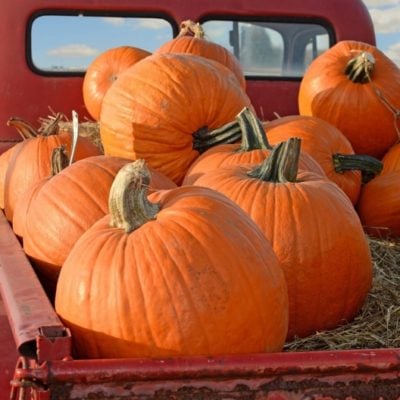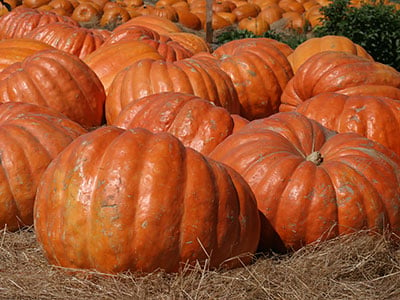
Learning Download: How to Grow Pumpkins
From Seed to Harvest: A guide to growing pumpkins.
Pumpkins can be grown for decorative and edible purposes, with different varieties grown to make pumpkin pie, carving for Halloween, to be used in canning and more. Pumpkins range in sizes from small, gourd-like varieties to large options and differ in color and outside texture as well.
To plant:
Since pumpkins grow best in warmer climates, plant them outside after all chances of frost have passed. pumpkins can be started indoors three weeks before the last frost date, but they do best when sowed directly into the garden. When planting in the garden, plant three to five seeds per mound about 1 inch deep. Planting in a mound keeps the soil warm and aids in germination, but pumpkins can also be planted in rows. If planting in a row, space seeds 6 to 12 inches apart. Plan accordingly, as pumpkins need lots of space to grow. If garden space is tight, pumpkins can be planted in 5- or 10-gallon buckets, or they can be planted along the edge of a garden where the vines can sprawl into the lawn or onto a sidewalk.
To grow:
Once pumpkins sprout, thin to two of the healthiest seedlings per mound. Make sure the pumpkins are in full sun and water them 1 inch per week, but don’t let water get on the leaves or the fruit. pumpkins do best in soil with a pH of 6.0 to 6.8. Once the pumpkins begin to form, pinch the fuzzy end of the vine to direct more energy to the pumpkin. Turn pumpkins regularly to encourage equal size but do so gently so you don’t damage the vine.
To harvest:
Pumpkins are ready to harvest when the color they are supposed to become is deep and rich. This is typically orange, although there are white pumpkins and other colors as well. Another way to tell if a pumpkin is ripe is to press a fingernail against its skin. If the skin resists puncture, it is ready for harvest. The rind should be hard, and the pumpkin should sound hollow when tapped. Cut the pumpkin off the vine with prunes, leaving 3-4 inches of stem.
What pumpkins crave:
Pumpkins are heavy feeders with a long growing season. Prior to planting in the garden, add compost and and aged manure to the soil. Add 1 cup of complete organic fertilizer below each plant prior to sowing and mix the fertilizer into the soil. Regularly treat pumpkins with compost and manure mixed with water or feed weekly with a fish or kelp-based fertilizer. Another option for fertilizing is to use a high-nitrogen fertilizer when plants are 1 foot tall and a high-phosphorous fertilizer before the blooming period starts.
Where to buy pumpkin seeds:
You can find pumpkin seeds for carving, canning, baking and decorative uses like traditional orange, heirloom, white and more in large and small sizes at Urban Farmer.
Learning Download: Common pests and diseases: Pumpkins
Common pests and diseases: Pumpkins
When growing vegetables, it is always exciting to care for the plant throughout its growing phase and then harvest it for delicious recipes later on, but one thing to watch out for is pests and diseases. Different plants are susceptible to different types of pests and diseases, and it is important to make yourself aware so you can keep a watchful eye and also take any preventative methods to keep your plants safe throughout their lifespan.
Pumpkins can fall victim to several different pests and diseases.
Pests:
The most common pests affecting pumpkins include aphids, armyworms and the cabbage looper, as well as others.
Aphids are soft-bodied insects that bring problems to lots of plants. They create discoloration of the leaves, necrotic spots and stunted growth. Use tolerant varieties and only apply insecticides if there’s a high infestation.
Armyworms will cause closely grouped holes in the foliage, and heavy feeding can cause leaves to become skeletonized. Pumpkin fruit will show shallow and dry wounds. You may see egg clusters on the leaves. To organically control armyworms, encourage natural enemies or apply Bacillus thuringiensis.
Cabbage loopers will leave large holes in the leaves and can cause lots of damage. Eggs are typically laid in singularly. To control cabbage loopers, encourage natural enemies or apply Bacillus thuringiensis.
Cabbage loopers will leave large holes in the leaves and can cause lots of damage. Eggs are typically laid in singularly. To control cabbage loopers, encourage natural enemies. You can handpick them from the plants, or apply Bacillus thuringiensis to kill the larvae. Stay away from chemical sprays which might harm natural predators.
Diseases:
Some of the common diseases affecting pumpkins include Alternaria leaf blight, Alternaria leaf spot and powdery mildew.
Alternaria leaf blight will cause small yellowish-brown spots with a green or yellow halo to appear on the older leaves first. Eventually the lesions expand and the leaves will curl and die. To prevent this disease, practice crop rotation to reduce levels of inoculum, remove crop debris from the field as quickly as possible or plow it deep into the soil and be sure to apply the appropriate fungicides when applicable. Another method of prevention is to water plants at the base rather than overhead.
Alternaria leaf spot causes round or irregular lesions on older leaves. This disease prefers wet conditions, and it is a fungus. It can be controlled by practicing crop rotation, destroying all crop debris after harvest and applying the appropriate fungicides.
Powdery mildew is also a fungus affecting pumpkins, and it causes a white or gray dusty material on the upper surface of the leaves. It spreads to cover the entire leaf, which then kills the leaf. This disease prefers high humidity, and it is best treated by applying the appropriate fungicides as soon as you notice a problem. This disease usually occurs on older leaves first, and it typically appears later in the growing season.
Learning Download: Pumpkin Comparison Chart
Pumpkin Comparison Chart
| Variety | Size | Days to Maturity | Color | Uses | |
| Atlantic Giant | 200-500 lbs. | 130 | Orange | Ornamental | |
| Autumn Buckskin | 12-15 lbs. | 110-120 | Beige | Baking and ornamental | |
| Big Max | 100 lbs. | 100 | Orange | Baking and carving | |
| Casper | 10-16 lbs. | 90 | White | Baking | |
| Cinderella | 25-35 lbs. | 110 | Orange | Baking and ornamental | |
| Connecticut Field | 15-20 lbs. | 115 | Orange | Carving | |
| Dickinson | 40 lbs. | 100-120 | Beige to orange | Baking | |
| Fairytale | 16-20 lbs. | 110 | Orange | Baking | |
| First Prize | 50-150 lbs. | 120 | Orange | Carving | |
| Halloween | 8-10 lbs. | 100 | Orange | Carving | |
| Harvest King | 25-35 lbs. | 120 | Orange | Carving | |
| Hooligan | 1/4 lb. | 95 | Orange and white mottled | Ornamental | |
| Howden | 20-25 lbs. | 105 | Orange | Carving | |
| Jack Be Little | 2-4 oz. | 90 | Orange | Ornamental | |
| Knuckle Head | 12-16 lbs. | 105 | Orange with knobs | Ornamental | |
| Lady Godiva | 5-10 lbs. | 100 | Orange and green | Baking and ornamental | |
| Mammoth Gold | 40-60 lbs. | 105 | Light orange | Baking | |
| Musquee de Provence | 20 lbs. | 125 | Brown | Baking | |
| Pepitas F1 | 9-12 lbs. | 90 | Orange with green stripes | Baking and ornamental | |
| Small Sugar | 6-8 lbs. | 90 | Orange | Baking | |
| Spookie | 5-6 lbs. | 85 | Orange | Baking and carving | |
| Ugly Duckling | 25 lbs. | 105 | Orange and yellow | Ornamental | |
| White Flat Boer Ford | 10-15 lbs. | 115 | White | Baking and ornamental | |
| Yellow of Paris | 25-50 lbs. | 100-110 | Peach to yellow | Baking | |
| Young’s Beauty | 10-12 lbs. | 95-120 | Orange | Carving |


